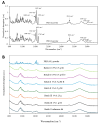The Formulation and Evaluation of Customized Prednisolone Gel Tablets Prepared by an Automated Extrusion-Based Material Deposition Method
- PMID: 39771511
- PMCID: PMC11677990
- DOI: 10.3390/pharmaceutics16121532
The Formulation and Evaluation of Customized Prednisolone Gel Tablets Prepared by an Automated Extrusion-Based Material Deposition Method
Abstract
Background/Objectives: An automated extrusion-based material deposition is a contemporary and rapid method for pharmaceutical dose-dispensing and preparing (printing) individualized solid dosage forms. The aim of this study was to investigate and gain knowledge of the feasibility of automated extrusion-based material deposition technology in preparing customized prednisolone (PRD)-loaded gel tablets for veterinary applications (primarily for dogs and cats). Methods: The PRD loads of the extrusion-based deposited gel tablets were 0.5% and 1.0%, and the target weights of tablets were 0.250 g, 0.500 g, and 1.000 g. The effects of the material deposition processes on the physical solid state, in vitro dissolution, and the physicochemical stability of PRD gel tablets were investigated. Results: The small-sized gel tablets presented a uniform round shape with an exceptionally smooth outer surface texture. The actual average weight of the tablets (n = 10) was very close to the target weight, showing the precision of the process. We found that PRD was in a pseudopolymorphic sesquihydrate form (instead of an initial PRD crystalline form II) in the gel tablets. In all the immediate-release gel tablets studied, more than 70% of the drug load was released within 30 min. The soft texture and dimensions of gel tablets affected the dissolution behaviour in vitro, suggesting the need for further development and standardization of a dissolution test method for such gel tablets. A short-term storage stability study revealed that the content of PRD did not decrease within 3 months. Conclusions: Automated extrusion-based material deposition is a feasible method for the rapid preparation of gel tablets intended for veterinary applications. In addition, the present technology and gel tablets could be used in pediatric and personalized medicine where precise dosing is crucial.
Keywords: automated extrusion-based material deposition; dissolution in vitro; gel tablet; prednisolone; solid-state change; storage stability; veterinary medicine.
Conflict of interest statement
The authors declare the following financial interests/personal relationships which may be considered as potential competing interests. This study was conducted in the framework of the joint research project between the University of Tartu (Institute of Pharmacy) and CurifyLabs Oy, Finland. The project is funded by CurifyLabs Oy, Finland. The authors (S.A. and N.S.T.) with affiliation to CurifyLabs Oy receive their salaries from the company and they have been involved in the design of the study, in the collection, analyses and interpretation of data and in the writing of the manuscript. S.A. reports a relationship with CurifyLabs Oy that includes employment. N.S.T. reports a relationship with CurifyLabs Oy that includes board membership, employment, and equity or stocks. All the other authors declare that they have no known competing financial interests or personal relationships that could have appeared to influence the work reported in this paper.
Figures







Similar articles
-
Towards a Customized Oral Drug Therapy for Pediatric Applications: Chewable Propranolol Gel Tablets Printed by an Automated Extrusion-Based Material Deposition Method.Pharmaceutics. 2025 Jul 4;17(7):881. doi: 10.3390/pharmaceutics17070881. Pharmaceutics. 2025. PMID: 40733091 Free PMC article.
-
Automated extrusion-based dispensing: Personalized dosing and quality control of clopidogrel tablets for pediatric care.Eur J Pharm Sci. 2025 Jan 1;204:106967. doi: 10.1016/j.ejps.2024.106967. Epub 2024 Nov 19. Eur J Pharm Sci. 2025. PMID: 39571628
-
Semi-solid extruded tablets for personalized pediatric use: Development, Quality control and In-Vitro Assessment of Enteral Tube Administration.Eur J Pharm Sci. 2025 Aug 1;211:107122. doi: 10.1016/j.ejps.2025.107122. Epub 2025 May 10. Eur J Pharm Sci. 2025. PMID: 40354986
-
Challenges, current status and emerging strategies in the development of rapidly dissolving FDM 3D-printed tablets: An overview and commentary.ADMET DMPK. 2023 Jan 1;11(1):33-55. doi: 10.5599/admet.1622. eCollection 2023. ADMET DMPK. 2023. PMID: 36778904 Free PMC article. Review.
-
3D Printing Technology as a Promising Tool to Design Nanomedicine-Based Solid Dosage Forms: Contemporary Research and Future Scope.Pharmaceutics. 2023 May 10;15(5):1448. doi: 10.3390/pharmaceutics15051448. Pharmaceutics. 2023. PMID: 37242690 Free PMC article. Review.
References
-
- Chatzitaki A.-T., Mystiridou E., Bouropoulos N., Ritzoulis C., Karavasili C., Fatouros D.G. Semi-solid extrusion 3D printing of starch-based soft dosage forms for the treatment of paediatric latent tuberculosis infection. J. Pharm. Pharmacol. 2022;74:1498–1506. doi: 10.1093/jpp/rgab121. - DOI - PubMed
-
- Mohammed A.A., Algahtani M.S., Ahmad M.Z., Ahmad J., Kotta S. 3D printing in medicine: Technology overview and drug delivery applications. Ann. 3D Print. Med. 2021;4:100037. doi: 10.1016/j.stlm.2021.100037. - DOI
Grants and funding
LinkOut - more resources
Full Text Sources
Miscellaneous

